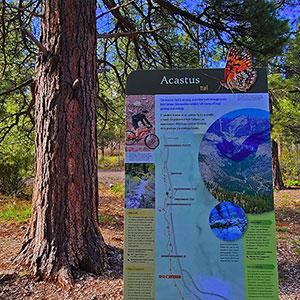Acastus Trail | Mt. Charleston Wilderness | Spring Mountains, Nevada
Overview | Acastus Trail | Mt. Charleston Wilderness | Spring Mountains, Nevada
The Acastus Trail is 1.5-mile (3-mile round trip) trail located in Kyle Canyon in Southern Nevada’s Mt. Charleston Wilderness in the Spring Mountains.
There is a trailhead on each end of the trail: The upper Western trailhead at the Fletcher Canyon Trailhead area on Kyle Canyon Road just below Charleston Village and the lower Eastern Trailhead at The Spring Mountains Visitor Gateway on Kyle Canyon Road just below that road’s intersection with Deer Creek Road.
There is about a 200ft elevation difference between the lower and upper end of the Acastus Trail, so it’s a matter of deciding whether you want to hike downhill at the beginning or at end of your adventure.
A Meditative Walk of Enlightenment
If you’ve ever walked The Stations of the Cross, a Labyrinth or other similar paths, you’re familiar with the concept of a Meditative Walk of Enlightenment.
What is a Meditative Walk of Enlightenment?
A Meditative Walk of Enlightenment is an act of slowing down to take in reality in a more deliberate, conscious way with a goal of reaching a new level of awareness. The walk usually features way points to stop and reflect, inviting you to deeply focus on a reality you might otherwise overlook, in order to gain a new level of understanding. The goal is that by deepening understanding and awareness in one area, you can become more conscious and aware in all areas. The Meditative Walk of Enlightenment invites us to take in reality in a new way. It’s a profoundly transformational process at the very core of one’s being.
How is The Acastus Trail a Meditative Walk of Enlightenment?
The focus of the 1.5-mile Acastus Trail is a slice of reality called The Spring Mountains. The goal is to slow down to become aware of this place in a new way that may then influence awareness of all places. As you walk the Acastus Trail, you are invited through beautiful interpretive signs to pause at various way points to learn and reflect on some aspect of nature, history or geography pertaining to The Spring Mountains. The truth is that all ground upon which we stand in any place is more deeply significant than our normally busy lives afford space to recognize and take in.
Allow your walk on the Acastus Trail to open a higher level of awareness of all places and your experience in them.
Your practice of A Meditative Walk of Enlightenment on The Acastus Trail can open a new practice of walking in all places.
Best Time of Year to Experience The Acastus Trail
Do not expect spectacular views here. The Acastus Trail is a more intimate, inner experience. However, there is a best time to walk The Acastus Trail: Aim for Fall or Spring in order to avoid freezing Winter temperatures or Summer heat that may rise toward 100 degrees. And, bring plenty of water for this dry desert environment.
Trailhead Directions | Acastus Trail | Mt. Charleston Wilderness | Spring Mountains, Nevada
Access this trail from the Fletcher Canyon Trailhead: Driving to the Fletcher Canyon Trailhead is pretty easy: Up I-95 North from Las Vegas, take a left at the Kyle Canyon exit, continue about 20 miles up Kyle Canyon Road, pass the traffic circle at The Spring Mountains Visitor Gateway, pass the Deer Creek Road turnoff and Mt Charleston Lodge and then onward for less than a quarter mile to The Fletcher Canyon Trailhead parking on your left. In all, it’s less than 40 miles from the Las Vegas Strip.
Trail Observations | Acastus Trail | Mt. Charleston Wilderness | Spring Mountains, Nevada
The Spring Mountains Desert Island
This adventure begins at The Fletcher Canyon Trailhead parking area on the upper Acastus Trail. The Acastus Trailhead can be found across a bridge behind the restroom. The Acastus Trail is named for the rare Acastus butterfly found only in The Spring Mountains. The Spring Mountains are actually a desert island, completely surrounded by The Mojave Desert. This has created an isolated plant and animal zone with many species found only here — nowhere else on earth! The Charleston Chipmunk is another example, but there are many more on this unique desert island.
Two Unique Climate Zones on The Acastus Trail
The Acastus Trail spans two very different climate zones beginning at about 7,000ft in the Ponderosa Pine zone of the upper Acastus Trail and ending in a much dryer climate zone at 6,400ft behind The Spring Mountains Visitor Gateway. Of course, you can take the trail beginning at the lower end at The Gateway, which would mean your return trip is downhill all the way!
If you’re staying at Fletcher View Campground or picnicking at Kyle Canyon Picnic Area and brought your bicycle, The Acastus Trail has a wide, well graded surface for most of its length and is excellent for cycling.
Ponderosa Pine and Flash Floods
The one of the first interpretative signs on the trail invites you to experience the majestic Ponderosa Pine with all your senses. The opposite panel is on the geology of the area. In particular this panel tells a story of flash floods. A recent flood in the area wiped out a campground below that had been in existence for 70 years. I once found remnants of flood-washed campground artifacts above the slot canyon at the upper Harris Springs parking area off Kyle Canyon Road. The panel tells the story of 20 people who died in a sudden flash flood on June 11, 2010 while camping in The Ouachita National Forest. For this reason campgrounds are no longer built in flood washes!
The two-panel structure sets a pattern for the interpretive signs on The Acastus Trail with the Western faced panels on life in the Spring Mountains and the Eastern faced panels on the geology of the area. Each sign along the trail is accompanied by a bench for rest and reflection.
Fletcher View Campground and Kyle Canyon Picnic Area
As you descend, the trail soon passes through a series of campground and picnic area roads along The Fletcher View Campground and Kyle Canyon Picnic Area. Just keep to your left (closest to the wash). At some confusing points there are little laminated paper signs that point where to turn to continue on the Acastus Trail. At the lower end of The Kyle Canyon Picnic Area, there is another trailhead sign for The Acastus Trail, and the trail will continue uninterrupted the rest of the way to its lower trailhead at The Spring Mountains Visitor Gateway.
Watching for Harris Mountain Summit Approach Ridges
Always watching for routes up to nearby mountain summits, at the lower side of The Kyle Canyon Picnic Area, I noticed a promising pathway branching upward onto a ridge that may lead to Harris Mountain Summit. In the videos on The Acastus Trail and Escarpment Trail you’ll see where I point out promising ridge routes to Harris Mountain Summit along with the ridge I took in the Harris/Griffith Circuit Adventure. What’s the value of an approach ridge from this area? This could have a great impact on a potential six-peak summit route and lead to Harris Mountain Summit without passing through The Rainbow Sub-division, with its private Summer homes.
Climate Transition Zone and Geological Forces
The next interpretive panel on the Acastus Trail discusses the transition between climate zones on the trail and how an earlier fire helped contribute to the dryer zone below. Damage to the fragile ecosystem can take centuries to repair. The opposite panel discusses geological change over time which has shaped and is shaping the Spring Mountains to this day.
Early Botanical and Geological Explorers and Desert Evergreens
The next interpretive sign on The Acastus Trail discusses early botanical explorers who discovered the unique nature of the plants and animals on this desert island of The Spring Mountains.
The next interpretive sign on The Acastus Trail discusses the hardy nature of desert evergreens like Pinyon Pines and Junipers. These plants have found a way to thrive in very harsh arid high desert areas. The opposite panel tells the story of the first geological explorers to The Spring Mountains who traveled the area on horseback documenting geological observations and theories.
The Rare Acastus Butterfly, The Spring Mountains as Desert Island and Ancient Sea Fossils Way Above Today’s Sea Level
The next panel is devoted to The Acastus Butterfly, for which the trail was named, found nowhere else on earth other than on this desert island. The opposite panel tells the history of the limestone formations in the Spring Mountains and how the entire area was once under an ancient sea. I have found ancient sea fossils at 11,000ft on and near Mummy’s Toe. This is a testament to how geological forces have shifted the land over time.
Plant/Animal Connections and Geological Fault Shifts
The next interpretive sign focuses on the connections between plants and animals in The Spring Mountains and how they have come to rely on one another. The opposite panel is on geological fault shifts that have created formations such as found on The Escarpment Trail where one level plain has been lifted over another, the border between the two being an escarpment cliff.
Hardy Desert Trees and Composite Rock Formations
The next interpretive sign focuses on three particular plants that thrive in hardy arid environments: Gambel Oak, Pointed Leaf Manzanita and Mountain Mahogany. These plants have roots that tap down hundreds of feet to the underground springs that continue to flow beneath dry mountain washes. In addition, their leaves have evolved to retain moisture by a folded shape that presents less surface area to the sun. The opposite panel describes the composite rock formations that create many of the weird shapes you seen in The Spring Mountains. These are composed of silt that washed down from the mountains, then bonded into solid mosaic blocks through calcification, the calcium being from ancient sea creatures. The cliffs of The Escarpment are formed of this kind of material. Look closely and you can see the individual stones that were bonded together. There is a lot of this composite rock bonding action in Death Valley, and a great example is the cliff walls of Natural Bridge Canyon.
Arrival at The Eastern Acastus Trailhead
As The Mt. Charleston Lodge, The Spring Mountains Visitor Gateway on your left (North) and The Escarpment on your right (South) come into view, you’ve arrived at the lower Acastus Trailhead in the wash below The Spring Mountains Visitor Gateway.
Physical, Intellectual and Spiritual Introduction to The Spring Mountains
This 1.5-mile interpretive trail has been an incredible introduction to The Spring Mountains, both intellectually, physically (altitude acclimatization) and spiritually to the extent you’ve allowed yourself to deeply experience the wonder of this unique area. Reflect beyond the information on the interpretive displays, allowing your imagination to enter the mindset of a first-time explorer, the wonder of the surrounding rock that has spanned hundreds of millions of years, plants and animals that live and adapt, quietly moving through their lives, experiencing their thoughts, and in so doing, allow your consciousness to rise to a new level of being in this place and in all places.



